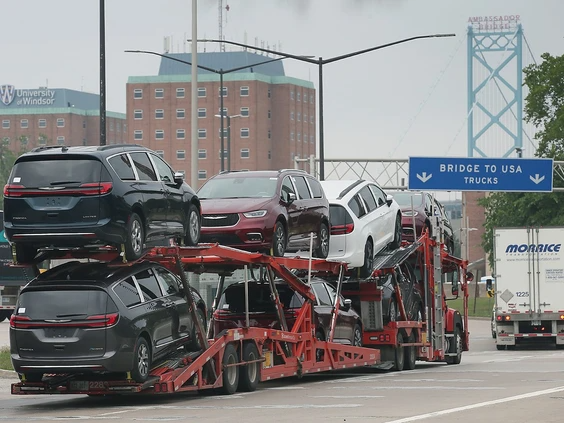Windsor/Sarnia part of $8-million automobility pilot project

A truck carrying newly built Windsor Chrysler Pacificas heads to the Ambassador Bridge in Windsor on Tuesday, June 27, 2023. PHOTO BY DAN JANISSE /Windsor Star
Federal Economic Development Agency for Southern Ontario minister Filomena Tassi announced Thursday at the Canadian International Auto Show that the Ontario Vehicle Innovation Network (OVIN), part of the Ontario Centre of Innovation, will oversee the two pilot projects.
“Southern Ontario plays a vital role in driving economic growth, especially when it comes to CAV and EV-related innovation and production,” Tassi said in a news release.
“OVIN’s Pilot Zones in Toronto and Windsor/Sarnia will support the testing and validating of cleaner and more efficient mobility technologies, which will help make a brighter future for us all.”
In addition to the technology pilot zones promoting commercialization, the projects will try to identify and breakdown the barriers to entry and testing in real-world environments.
While no start date for the pilots was released, Automobility and Innovation Centre interim director Ed Dawson said his organization would be involved in providing access to a digital twin of border crossings and in supporting companies developing their technology. The Automobility centre is one of OVIN’s seven regional technology centres.
“The tunnel and the Gordie Howe bridge are the facilities I think will be involved in Windsor and the Blue Water Bridge in Sarnia,” Dawson said.
“They’ll looking the different crossings, different logistics, different flow of goods and how people move.
“This will be exciting because the doing live testing is really important. Simulation is one aspect, but you have to have both simulation and real world testing and we’ve not had the opportunity to do real live testing on the border.”
Tassi said southern Ontario is the logical location for the pilot programs with the region having emerged as a hub of zero emission and autonomous vehicle research. The region will be the home of battery plants in Windsor and St. Thomas and is attracting businesses and entrepreneurs eager to tap into the expanding and increasingly green automobility supply chain.
In the past three years, the automotive and battery sectors have committed over $28 billion worth of investment in Ontario. The province’s Minister of Economic Development, Job Creation and Trade Vic Fedeli expects that figure to grow in 2024.
“As the automotive sector continues to evolve, it is essential that (small and medium businesses) across Ontario are equipped with the tools and resources necessary to ensure their success,” Fedeli said.
“The Ontario Vehicle Innovation Network’s Technology Pilot Zones will play a key role in fostering innovation, economic growth and supporting job creation, allowing companies to take their cutting-edge electric and autonomous vehicle technologies to new heights.”
Southern Ontario also provides the real-world environments desired for the project with two of the nation’s busiest border-crossing points in Windsor and Sarnia.
Approximately a quarter of all traffic annually between Canada and the U.S. crosses the Ambassador Bridge in Windsor and nearly $10 billion worth of trade each month. Sarnia’s Blue Water Bridge is the nation’s second busiest commercial crossing after Windsor and the two bridges account for over 40 per cent of the flow of trade with the U.S.
Windsor was also part of a recent two-year World Economic Forum study on cross-border automobility integration involving southeastern Michigan.
Trillium Network for Advance Manufacturing managing director Brendan Sweeney said similar OVIN regional projects focused on electric vehicles for use in the mining industry in Sudbury have been very well received. He expects a similar response from companies involved in the pilot programs.
“This is going to be a real high-tech bridge,” Sweeney said.
“To have a commitment to develop and test Canadian technology alongside the bridge’s is really a good resource.
“It doesn’t count as a massive investment, but you never know what technology or company or partnership with an existing company will develop if you don’t fund these type of investments.”




